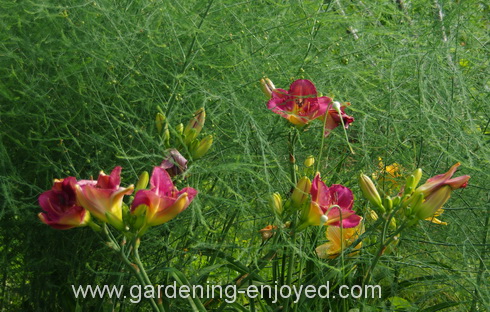
Summer seems to be arriving and the Daylilies are the best summer perennial. They bloom for several weeks and have few if any bugs or diseases. I have several in a variety of colours, pinks, yellows, purples and oranges and maybe some attempts at white which are a rich cream colour. What you see in the picture is one of my blending tricks. The daylilies look much better surrounded with some nice soft fern so we interplant them with the Asparagus. Its fern tops that grow all summer to regenerate the roots for next spring, make a great background for the blooms and lets that bed do double duty all season long. Now if someone could just get blue into the Daylily palette. Gardeners are never satisfied!!
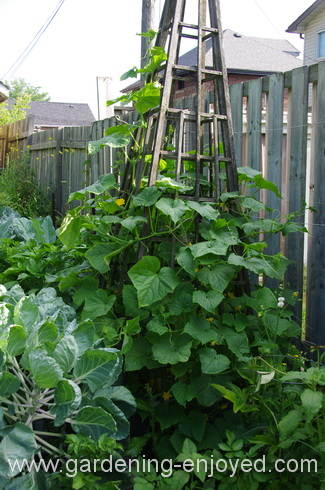 This seems to be the year for Cucumbers. There are six plants in a large subirrigation container and they are already almost to the to top of the 2.5m trellis. We have eaten a couple of small ones and there are plenty more coming. I have seen a few striped Cucumber Beetles but so far not enough to do any serious damage. Those bugs biggest damage on Cucumbers tends to be the attack on the roots by the larva. The container has its plastic cover over it and that makes it difficult for the Beetles to get down and lay their eggs. This container is not an Earthbox but rather one I made myself so that it would fit inside the trellis I had always used for Cucumbers. Last year they were very chlorotic and I wonder if I forget to add the fertilizer. I made sure there was sufficient
this year. As usual I use Acti-sol for my fertilizer because it is completely organic. I have another container with Cucumber Baby Fingers growing in it and they have reached beyond the 1m wire trellis and are looking for somewhere to go. Apparently just because they produce baby Cucumbers it doesn’t mean they grow baby plants. We, actually that’s not true, the Assistant Gardener has eaten a few of these treats and I have to admit it’s one of the few vegetables that I’m not that fond of.
This seems to be the year for Cucumbers. There are six plants in a large subirrigation container and they are already almost to the to top of the 2.5m trellis. We have eaten a couple of small ones and there are plenty more coming. I have seen a few striped Cucumber Beetles but so far not enough to do any serious damage. Those bugs biggest damage on Cucumbers tends to be the attack on the roots by the larva. The container has its plastic cover over it and that makes it difficult for the Beetles to get down and lay their eggs. This container is not an Earthbox but rather one I made myself so that it would fit inside the trellis I had always used for Cucumbers. Last year they were very chlorotic and I wonder if I forget to add the fertilizer. I made sure there was sufficient
this year. As usual I use Acti-sol for my fertilizer because it is completely organic. I have another container with Cucumber Baby Fingers growing in it and they have reached beyond the 1m wire trellis and are looking for somewhere to go. Apparently just because they produce baby Cucumbers it doesn’t mean they grow baby plants. We, actually that’s not true, the Assistant Gardener has eaten a few of these treats and I have to admit it’s one of the few vegetables that I’m not that fond of.
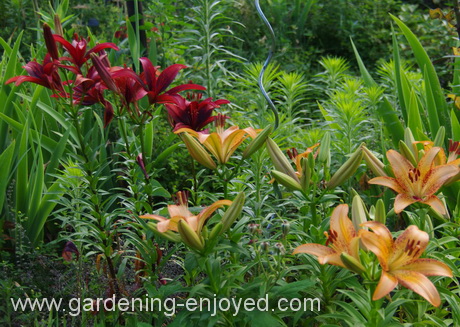
My other summer flowers are my true Lilies. I must admit to liking them better than the Daylilies but they are not trouble free. The Red Lily Beetle has been mostly absent this year and that has allowed the Lilies to flourish. In my university days, that was a long time ago, I spent parts of my summers helping to plant and care for the Lily fields of the University’s Lily breeder. I learned to love them then and that has apparently stayed with me. I’m learning to like the newer interspecific hybrids such as the crosses between Oriental Lilies and Trumpet Lilies that give us the Orienpets such as Golden Stargazer, that exhibit great hybrid vigour with tall sturdy stems and multiple large flowers. The two in the picture are Asiatic Lilies which are some of the first to bloom and remind me of my
love affair with this group of plants.
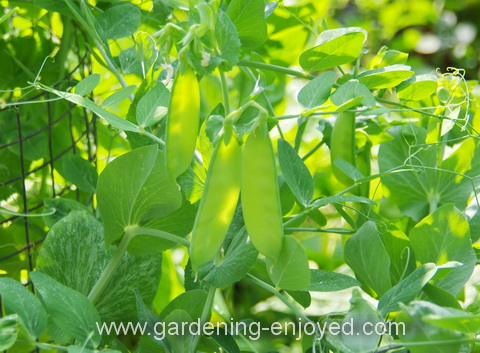
This is a tasty reminder of how late the season is this year. These delicious Snow Peas are usually finished by the beginning of July and here we are eating them now. I seem to have produced an abundant crop this year. I used to plant them along a stone wall and let them tumble over but this year I put them in the main garden with a circle of hardware cloth to hold them up and we have more then enough to fill our plates. Now the trick is to eat them fast enough that they don’t get overly mature and a bit tough. Not a difficult chore.
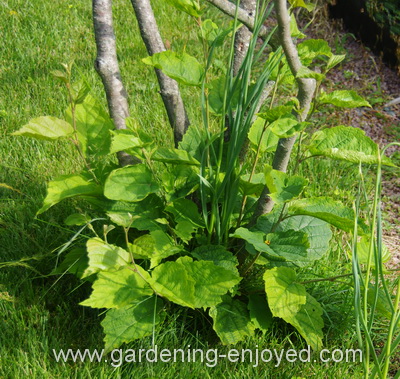 I had two questions from the last issue about trees that had suckers growing from their base. Here is the same problem on my Witch Hazel tree. Diane is her variety name and she is lovely but she will not come true from seed as she is a hybrid. To solve this problem trees like Diane are grafted onto a species root stock so that they can be propagated in commercial quantifies. Those root stocks are often quite hardy and vigorous and that’s why they are used. The down side is they are hardy and vigorous and may not be content just being the roots for a prettier variety. They start to produce above ground shoots that grow in clusters at the base of the tree and create work for us. These growths need to be pruned off regularly, usually once a year, before they take off and grow faster and bigger than the desirable tree. It’s a small easy chore that maintains the plant that we purchased and want to keep.
I had two questions from the last issue about trees that had suckers growing from their base. Here is the same problem on my Witch Hazel tree. Diane is her variety name and she is lovely but she will not come true from seed as she is a hybrid. To solve this problem trees like Diane are grafted onto a species root stock so that they can be propagated in commercial quantifies. Those root stocks are often quite hardy and vigorous and that’s why they are used. The down side is they are hardy and vigorous and may not be content just being the roots for a prettier variety. They start to produce above ground shoots that grow in clusters at the base of the tree and create work for us. These growths need to be pruned off regularly, usually once a year, before they take off and grow faster and bigger than the desirable tree. It’s a small easy chore that maintains the plant that we purchased and want to keep.
Now it’s time to answer a few of my reader’s
questions. To ask a question just “reply” to this ezine. Don’t forget to check the front page of the Website for frequent short ideas for current gardening activities.
Hilde Asks? My hydrangea paniculata tree is looking odd. The leaves have green ribs but the rest of the leaves are pale greenish yellow. My friend's raspberries, all but one type which is green, exhibiting the same leaves. Another friend's rooftop hydrangea is all green except for one small branch which is the same green ribs and yellow between the veins.
Ken Answers! The yellow leaves with green veins on the Hydrangea is quite common and is usually an iron deficiency. There are several products out there that can be applied to the soil or to the leaves to try and correct that problem.
Josephine Asks? I also have a whole bunch of some three leaf weed with little white in the leaves. I think
its called clover leaves in my lawn from the neighbors portion of the lawn. It is filling into my portion of the lawn. I have tried the weed be gone but it comes back in a few days again. Please help as I am getting fed up of wasting money on trying to get rid of these plants. I cannot find the root as its a very fine plant in the grass. I am trying the over seeding in that area by pouring lots of grass seed into that area but no help on the way.
Ken Answers! It’s difficult to answer without a picture but the plant sounds like Goutweed although it is usually bigger than you indicate. It has very deep roots which may be why you can’t find any. It is nearly impossible to eradicate from a lawn. Continuing to mow it down will discourage it but it will probably continue to pop up. Killing the entire lawn and starting over may not even work if it is invading from the neighbours. Not the answer you wanted but??
|

 This seems to be the year for Cucumbers. There are six plants in a large subirrigation container and they are already almost to the to top of the 2.5m trellis. We have eaten a couple of small ones and there are plenty more coming. I have seen a few striped Cucumber Beetles but so far not enough to do any serious damage. Those bugs biggest damage on Cucumbers tends to be the attack on the roots by the larva. The container has its plastic cover over it and that makes it difficult for the Beetles to get down and lay their eggs. This container is not an Earthbox but rather one I made myself so that it would fit inside the trellis I had always used for Cucumbers. Last year they were very chlorotic and I wonder if I forget to add the fertilizer. I made sure there was sufficient
this year. As usual I use Acti-sol for my fertilizer because it is completely organic. I have another container with Cucumber Baby Fingers growing in it and they have reached beyond the 1m wire trellis and are looking for somewhere to go. Apparently just because they produce baby Cucumbers it doesn’t mean they grow baby plants. We, actually that’s not true, the Assistant Gardener has eaten a few of these treats and I have to admit it’s one of the few vegetables that I’m not that fond of.
This seems to be the year for Cucumbers. There are six plants in a large subirrigation container and they are already almost to the to top of the 2.5m trellis. We have eaten a couple of small ones and there are plenty more coming. I have seen a few striped Cucumber Beetles but so far not enough to do any serious damage. Those bugs biggest damage on Cucumbers tends to be the attack on the roots by the larva. The container has its plastic cover over it and that makes it difficult for the Beetles to get down and lay their eggs. This container is not an Earthbox but rather one I made myself so that it would fit inside the trellis I had always used for Cucumbers. Last year they were very chlorotic and I wonder if I forget to add the fertilizer. I made sure there was sufficient
this year. As usual I use Acti-sol for my fertilizer because it is completely organic. I have another container with Cucumber Baby Fingers growing in it and they have reached beyond the 1m wire trellis and are looking for somewhere to go. Apparently just because they produce baby Cucumbers it doesn’t mean they grow baby plants. We, actually that’s not true, the Assistant Gardener has eaten a few of these treats and I have to admit it’s one of the few vegetables that I’m not that fond of. I had two questions from the last issue about trees that had suckers growing from their base. Here is the same problem on my Witch Hazel tree. Diane is her variety name and she is lovely but she will not come true from seed as she is a hybrid. To solve this problem trees like Diane are grafted onto a species root stock so that they can be propagated in commercial quantifies. Those root stocks are often quite hardy and vigorous and that’s why they are used. The down side is they are hardy and vigorous and may not be content just being the roots for a prettier variety. They start to produce above ground shoots that grow in clusters at the base of the tree and create work for us. These growths need to be pruned off regularly, usually once a year, before they take off and grow faster and bigger than the desirable tree. It’s a small easy chore that maintains the plant that we purchased and want to keep.
I had two questions from the last issue about trees that had suckers growing from their base. Here is the same problem on my Witch Hazel tree. Diane is her variety name and she is lovely but she will not come true from seed as she is a hybrid. To solve this problem trees like Diane are grafted onto a species root stock so that they can be propagated in commercial quantifies. Those root stocks are often quite hardy and vigorous and that’s why they are used. The down side is they are hardy and vigorous and may not be content just being the roots for a prettier variety. They start to produce above ground shoots that grow in clusters at the base of the tree and create work for us. These growths need to be pruned off regularly, usually once a year, before they take off and grow faster and bigger than the desirable tree. It’s a small easy chore that maintains the plant that we purchased and want to keep.

